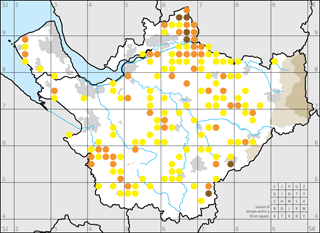Distribution of bird groups
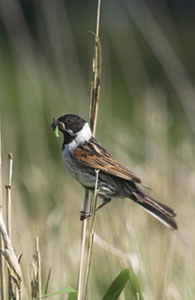
Reed Bunting is a Red-listed species that
Is quite widespread on the county's
farmland.
Figure 4 depicts tetrads with breeding season presence of six (yellow), seven (orange) or eight (brown) of the red-listed species of conservation concern that mainly frequent farmland: Grey Partridge, Skylark, Tree Sparrow, Linnet, Bullfinch, Yellowhammer, Reed Bunting and Corn Bunting; the almost-ubiquitous Song Thrush, Starling and House Sparrow are omitted. The concentration around Warrington in SJ68, SJ69 and SJ78 is striking, corresponding to the main areas of arable agriculture in the county. There are other hotspots around Blakenhall (SJ74I/ J) and Alsager (SJ75X), although too much should not be made of the presence or absence of just one or two species. The mainly pastoral areas of southwest Cheshire are also especially important.
Figure 5 shows tetrads with breeding season presence of three (green), four (orange) or five (brown) of the six species Goosander, Common Sandpiper, Kingfisher, Sand Martin, Grey Wagtail and Dipper. Apart from three tetrads on the river Dee, all of the important sites are in the east of Cheshire, with the Dane the premier river system in the county. This Atlas shows a mixed picture for the county's river birds: Goosanders have started breeding in the last twenty years and Grey Wagtails have increased greatly, but Dippers and Common Sandpipers have declined, with Kingfishers showing varied fortunes.
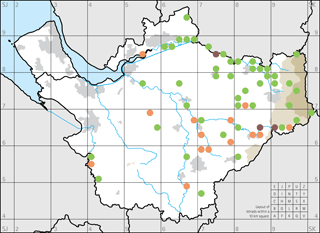
Figure 5: River species.
The county does not have much high-quality woodland, so the range of some specialist species is restricted. Figure 6 shows tetrads holding three (green), four (orange) or all six (brown) of the six breeding species Green Woodpecker, Tree Pipit, Redstart, Wood Warbler, Pied Flycatcher and Marsh Tit. Other obvious woodland birds are omitted as they are so widespread, such as Great Spotted Woodpecker, Nuthatch and Treecreeper. The best tetrad for these special woodland birds is clearly Langley (SJ97K), with other concentrations in the same area and also Delamere Forest (SJ57 F/K), Peckforton (SJ55I/J) and Lyme Park (SJ98).
The major wetlands for breeding birds are shown by Figure 7, which depicts tetrads holding six (yellow), seven (orange), eight (red) or nine, ten or eleven (brown) of the eleven species Mute Swan, Greylag Goose, Canada Goose, Mandarin, Gadwall, Shoveler, Pochard, Ruddy Duck, Little Grebe, Great Crested Grebe and Black- necked Grebe. The main areas are along the Mersey valley from Woolston (SJ68J/P/U) to Astmoor (SJ58H), Tatton/Rostherne (SJ77P/SJ78K/L/M) and Doddington (SJ74D), with other important areas including Frodsham Marsh (SJ47Z), the lower Weaver valley (SJ57N/P/T), Anderton/Marbury (Great Budworth)/Neumann's Flash (SJ67M/N/S), Chelford Sand Quarries (SJ87), Astbury Mere (SJ85D) and the south Cheshire meres on the Cholmondeley estate (SJ45/55). The only Wirral tetrads to feature are those including Inner Marsh Farm (SJ37B) and Meols (SJ28J). Note that this Atlas is based on tetrads, not sites, and some individual sites appear to have greater prominence than others if they happen to span more than one tetrad.
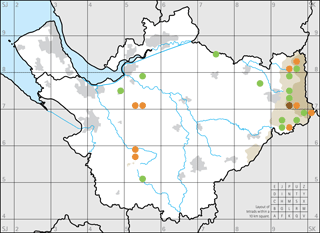
Figure 6: Deciduous woodland specialists.
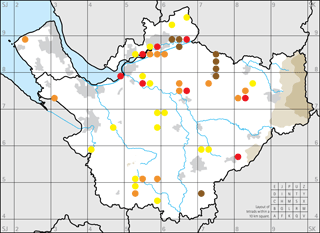
Figure 7: Wetland breeders.
Although it does not show on a map like this, one notable result of this Atlas has been the extension of breeding onto smaller waters by several waterfowl, especially Canada Goose, Greylag Goose, Coot and Tufted Duck; Moorhen and Little Grebe may have suffered from this intrusion into their domain.
Far more waterfowl winter in the county, and most tetrads hold a few species, so Figure 8 depicts tetrads with 13 or 14 species (yellow), 15 or 16 species (red) or 17–26 species (brown), highlighting the well-known areas of the estuaries, with inland meres, sand quarries and dredging deposit grounds.
Those tetrads with nine or more wintering wader species are shown in Figure 9. The only tetrads away from the vicinity of the estuaries are Neumann's Flash (SJ67S) and Sandbach Flashes (SJ75J).
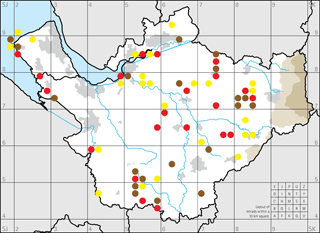
Figure 8: Winter waterfowl.
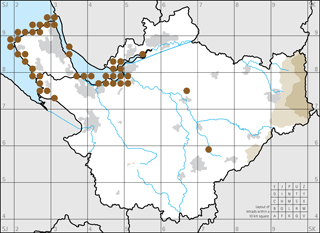
Figure 9: Wintering waders.

